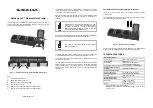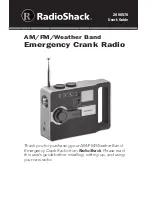
14
15
Wireless weather station
• Open the battery compartment of the weather station and the outdoor
transmitter (screwed) and place both instruments on a desk with a dis-
tance of approximately 1.5 meter. Check that no other electronic devices
are close.
• Insert 2 x AAA 1,5 V batteries first into the battery compartment of the
outdoor transmitter and immediately afterwards 2 x AA 1,5 V in the
weather station, observing the correct polarity.
6.2 Reception of outdoor temperature and DCF time
• When the weather station is powered up, a short beep will sound and all
LCD segments will light up for about 4 seconds before it enters into
learning mode to learn the sensors security code.
• After the outdoor transmitter is powered up, it will transmit temperature
16 times every 8 sec. (later every 48 seconds), and then the outdoor
transmitter will start radio-controlled time reception. During the DCF time
reception period (maximum 10 minutes), no weather data will be trans-
mitted.
•
Note: DO NOT PRESS ANY BUTTON
during the first 10 minutes learning
period or before radio-controlled time is displayed on the receiver. After
both outdoor temperature and radio-controlled time are displayed you
can place your outdoor transmitter outdoors at the final destination. In
case the clock cannot detect the DCF-signal (for example due to distur-
bances, transmitting distance, etc.), the time can be set manually. If the
outdoor weather data is not displayed or if any button is pressed before
the weather station receives the signal, or when changing batteries you
will need to follow the battery installation procedure again. Please wait
minimum 10 seconds before inserting the batteries again to make a pro-
per reset for both weather station and the outdoor transmitter.
Note for radio-controlled time DCF
The time base for the radio-controlled time is a caesium atomic clock oper-
ated by the Physikalisch Technische Bundesanstalt Braunschweig. It has a
time deviation of less than one second in one million years. The time is
coded and transmitted from Mainflingen near Frankfurt via frequency signal
DCF-77 (77.5 kHz) and has a transmitting range of approximately 1,500 km.
Your radio-controlled clock receives this signal and converts it to show the
precise time. Changeover from summer time or winter time is automatic.
The quality of the reception depends mainly on the geographic location.
Normally there should be no reception problems within a 1,500 km radius
around Frankfurt.
Please take note of the following:
• The recommended distance to any interfering sources like computer
monitors or TV sets is a minimum of 1.5 - 2 metres.
• Within ferro-concrete rooms (basements, superstructures), the received
signal is naturally weakened. In extreme cases, please place the unit
close to a window and/or point its front or back towards the Frankfurt
transmitter.
Wireless weather station
• Low batteries should be changed as soon as possible to prevent damage
caused by leaking.
• Never use a combination of old and new batteries together, nor batteries
of different types.
• Avoid contact with skin, eyes and mucous membranes when handling
leaking batteries. In case of contact, immediately rinse the affected areas
with water and consult a doctor.
Important information on product safety!
• Do not expose the device to extreme temperatures, vibrations or shocks.
• Protect it from moisture.
• The outdoor transmitter is protected against splash water, but is not
watertight. Choose a shady and dry position for the transmitter.
5. Elements
5.1 Receiver (base station) (Fig. 1):
LCD
1.
Weather tendency arrow
2.
Weather forecast icon
3.
Time alarm icon
4.
DCF tower icon for time reception
5.
Time / Date
6.
MIN/MAX icon
7.
Base station low battery indicator
8.
Indoor temperature display
9.
Indoor humidity display
10.
MIN/MAX icon
11.
Transmitter low battery indicator
12.
Outdoor temperature display
13.
Number showing outdoor transmitter
14.
Outdoor reception signal
Buttons:
B 1:
+/CH
button
B 2:
SET/MODE
button
B 3:
-/MIN/MAX
button
Housing:
C 1:
Wall mount hole
C 2:
Battery compartment
C 3:
Stand (fold out)
5.2 Sensor unit (Transmitter) (Fig. 2):
D 1:
Outdoor temperature
D 2:
Wall bracket
D 3:
Battery compartment
6. Getting started
6.1 Insert batteries
• Remove the protective foil from the display of the weather station.
TFA_No_35.1079_Anleitung_08_22 06.09.2022 8:24 Uhr Seite 8









































